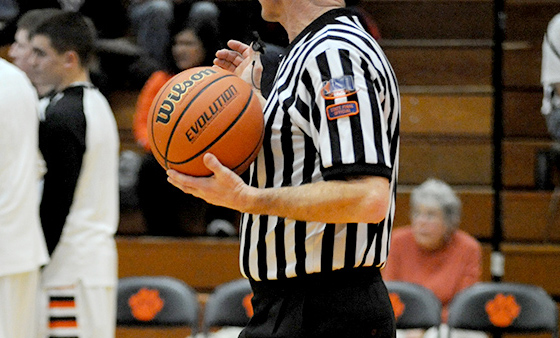Defending Various Delay Offenses
Last month we discussed a specific plan on how to defend the “Four-Corners” delay game. There are many other forms of delay games that offenses utilize for last second shots at the end of time periods and to preserve leads late in games. A good coaching staff should have a defensive game plan for other types of delay offenses such as the three offenses mentioned below.
A general philosophy utilized to counter-attack the Four-Corners offense should be incorporated into a defensive philosophy used for other delay games. This could summarily be that the defensive team is the aggressor so that the somewhat passive delay offense must adjust and react to that defense.
If the defensive coach scouts and studies the opposition’s offense, he/she should be able to uncover the weaknesses and flaws of the offense. That defensive coach can then formulate a fundamentally sound defensive game plan that can profit from on the opposition’s weaknesses while defusing the delay offense’s strengths.
We finally came up with a game saver based on the use of our defensive tips as acronyms. Namely: (proper) Technique, (proper) Intensity, (proper) Positioning and (proper) Stance.
Every defender must always execute with the correct techniques, with a maximum (but controlled) intense effort. Every player must also be in the correct location and proper defensive stance to increase the likelihood defensive team success.
Knowing the restrictions of the opposing delay offense (predicated on time and score situations) can free up the defense to be more aggressive and increase its calculated degree of gambling.
A coaching staff should also incorporate and utilize the same knowledge of substitution techniques, fouling techniques, and the same timeout administration.
Defending the “Triangle Delay Game”
Diag. 1 illustrates the first of three offensive sets that can be called the “Triangle Delay Game.” The defensive terminology is that the Defensive Guards (DG1 and DG2) should defend 1 and 2; the two Defensive Wings (DW5 and DW4) are assigned to defend 5 and 4, while the Defensive Center (DC3) is responsible for 3.
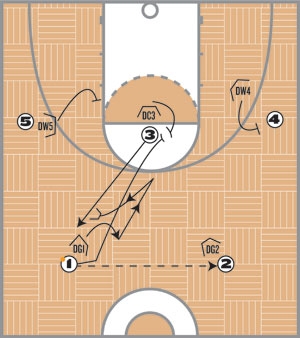 |
| DIAG 1. |
This particular offense expects the defense to allow the guard-to-guard pass (from 1 to 2) followed by the original passing guard to set an off-the-ball screen for 3 to pop out to the now vacant guard spot. See Diag. 1.
Defensive players attacking this particular delay game offense should apply the following techniques:
• Always anticipate all off-the-ball screens and automatically switch them.
• Jump trap all ballscreens.
• Jump trap all dribble hand-offs and crosses.
• Jump switch all hard dribble approaches.
• Substitute properly for defensive and offensive specialists on free- throw situations.
• Know which opponents are the strongest and the weakest ballhandlers.
• Know what opponents are the strongest and the weakest free-throw shooters.
• Know whom, when and how to properly foul without getting called for intentional fouls.
• Know what kind of shot is to be taken when the players transition into their own offense.
• Be prepared to full-court press (or call a timeout) after scoring on their own offense.
• Be proficient in their own free-throw shooting so that the defensive subs can come in after the last free throw is made (in order to set up a full-court press.)
Ball defenders (DG1 in Diag. 1) could overplay the ball by either “fanning the ball” toward the sideline away from the basket and teammates or having the defender “funnel the ball” toward the middle of the floor where there is a congestion of all the offensive and defensive players.
This could possibly lead to the defensive team executing a close run and jump traps or switches on the dribbler.
The ballside Defensive Wing (DW5) in Diag. 1 denies the pass from 1 to 5 while helpside Defensive Wing (DW4) will sag off to help in case of backdoor cuts by 5 or 3.
A more specific defensive plan of attack can be used against the “Triangle Delay Game” by initially starting in a man-to-man defense that flows into a 2-2-1 Half-Court Zone Trap.
Diags. 2 and 3 illustrate this (“man-to-zone press”) plan of action. DG2 pressures the ball (by “fanning the ball”) while there is a strong denial of passes to either 1, 4 or 3. If 2 dribbles hard toward 4, DW4 must run and jump switches onto the dribbler with DG 2 switching to 4. See Diag. 2.
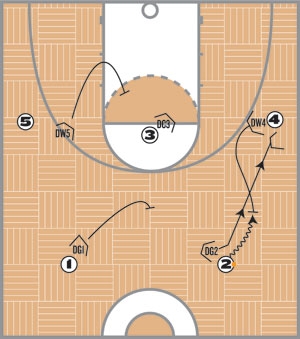 |
| DIAG. 2 |
If no turnovers are committed and 4 receives the pass, the offense has escaped a highly dangerous situation. With 4 having the ball on a clearly defined ballside and with DG2 now pressuring the ball, there is a defensive mismatch of great advantage to the defense.
This defensive mismatch has a strong defender now on a much inferior offensive ballhandler.
 |
| DIAG. 3 |
DG2 can then use the sideline and eventually the baseline as extra defenders and continue “fanning the ball” toward the deep corner.
DW4 can then quickly attack the (poorer) ballhandler in the corner from behind, while DW5 becomes the “protector/defensive safety.” DC3 and DG1 rotate into positions so that they can defend the zone areas – the most likely areas where pass receivers would go to escape the dribble trap in the deep corner.
If by chance the offensive ballhandler (4) escapes out of the trap, all defenders must rotate quickly to their original offensive men.
With the offensive team in a “delay game” mode (a non-attacking type of offense) the small amount of time the defense needs to reset does not place the defense in a precarious situation. See Diag. 3.
Defending the “High Stacks Delay Game”
Diag. 4 illustrates this offense and the defensive alignment that can be used. This offense is predicated normally on the top player on both stacks do down-screen for the player that is stacked low to pop out further towards the timeline.
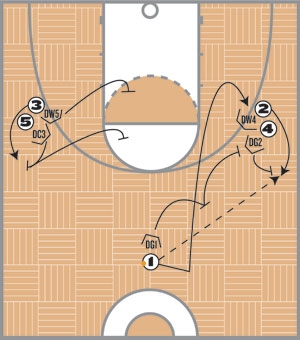 |
| DIAG. 4 |
Upon receiving the pass, the passer cuts toward the basket before settling in at the low spot of the stack. Defenders should apply the same general defensive techniques as well as executing specific techniques that can be very successful against this delay offense.
The first specific technique is that in anticipation of the downscreens and the pop-outs, DG2 and DC3 initially start as if they are defending 4 and 5, respectively.
When 4 and 5 set their screens and 2 and 3 pop out, DG2 and DC3 will already be there to help deny the first pass or at least to force the potential pass receiver further out (closer towards the timeline and possibly the sideline).
1 first jumps to the ball and then goes to the high side of the stack, while the two defenders (DC3 and DW5) also jump to the ball and sag off to provide support defense.
The strong supportive helpside defense will allow the defense on the ballside to exert maximum pressure both on the ball and the ballside pass receivers.
DG2 could and should use the timeline and the sideline as extra defenders to pressure and help force turnovers on a ballhandler who suddenly is not in a very good offensive location. See Diag. 5.
 |
| DIAG. 5 |
Diag. 6 illustrates a possible defensive stunt where 1 makes the same pass to 2. DG2 anticipates the pass and forces 2 further out. DG1, DC3 and DW5 quickly react to the pass.
 |
| DIAG. 6 |
When DG2 “fans” the ball toward the sideline, DG1 will then run and attack the ball from the dribbler’s blind spot with a “surprise trap” on the ball by DG2. DW4 “zones up” and defends both 1 and 4 who are stacked closely together, while DW5 rotates over to help out on them.
DC3 anticipates the long reversal pass from 2 to 3. If the ball escapes out of the offensive predicament, all players quickly recover to their original men.
A defensive wrinkle that could be applied in this offense is to make the defense appear to be a man-to-man defense, but actually be aligned in a half-court 1-2-2 trap defensive set.
To disguise the defense and to maximize it, both defensive zone Trap Wings (TW3 and TW2) do not trap the ball in the center with the Trap Point (TP1), but wait to double-team the ball (with TP1) in the high corner wing areas. See Diag. 7.
 |
| DIAG. 7 |
When 1 passes the ball to 3, the new ballside Trap Wing (TW3) and the Trap Point (TP1), attack the ball with a “half-court zone” type of trap. The ballside Trap Corner (TC5) stays near his original area and looks for a possible interception on the ballside of the court.
The offside Trap Wing (TW2) and the offside Trap Corner (TC4) “jump to the ball” and provide zone help for the ball defenders. See Diag. 8.
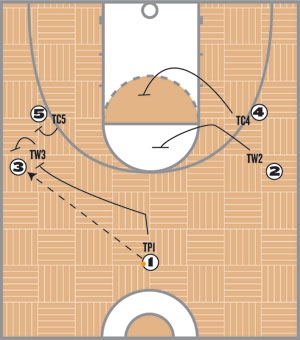 |
| DIAG. 8 |
If 3 escapes out of the trap with a pass down the sideline, TC5 should “fan” the ball down the sideline to the corner. All other defenders should rotate back to their original men and look to deny any outlet passes while the offense has placed itself in a dangerous predicament. Presumably, 5 is a poorer ballhandler than most of the other offensive players. 5 must now use his left hand (very possibly his weaker hand) down to the deep corner, where TC5 would not need another teammate to help trap the ball.
TC5, instead, uses the sideline and the baseline as 6th and 7th defenders. This frees up TC5’s teammates to be able to deny any outlet passes from 5. See Diag. 9.
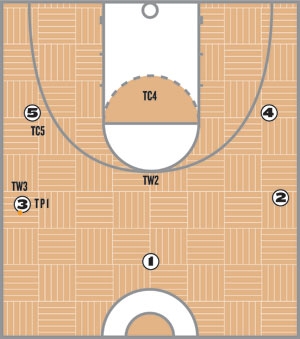 |
| DIAG. 9 |
Defending the “5-Out Delay Game”
This delay game is a version of the “4 Corners Delay Game,” but with both offensive corner players moved up to the free-throw line extended. This pulls all 10 players wider and up to the wing areas or higher. See Diag. 10.
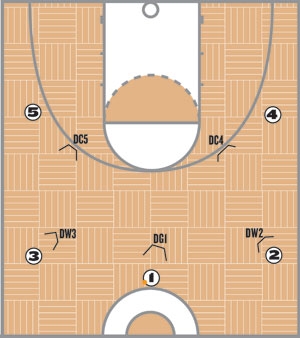 |
| DIAG. 10 |
DG1 must pressure the ball and “fan the ball” toward either sideline, preferably towards the weaker hand of 1 or toward 1’s presumed weaker offensive teammates. The two
Defensive Wings (DW3 and DW2) must deny the pass from 1. The two Defensive Corners (DC5 and DC4) must position themselves to be able to play support defense so that they can successfully:
• Stop deep middle penetration by 1.
• Stop back-door cuts by 3 or 2.
• Help influence the ball to either 5 or 4 who should most likely be the two poorest ballhandlers (and possibly poor free throw shooters).
• Specifically channel the ball to 5 (if he is a right-handed ballhandler on the left side of the court),
• Encourage the ball to end up in the hands of 4 (if he is a left-handed ballhandler on the right side of the court).
If one of these two offensive frontline players (5 or 4) actually do receive the ball, it is most likely not what the delay offense is striving for. The most likely will be a poorer ballhandler in a more dangerous location on the court for the offense. 5 receives the pass from 1, because all other offensive players are denied the pass. TC5 first uses the sideline and ultimately the sideline and baseline as extra defensive teammates to pressure one of the poorest ballhandlers on the court.
Every defender could employ the option of staying on his original offensive opponent and denying the outlet pass from 5 in the deep corner. This is very effective when 5 kills his/her dribble in the deep corner and has no driving opportunities, no shot opportunities and the ball cannot escape out of the corner. See Diag. 11.
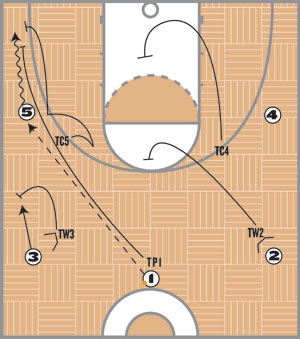 |
| DIAG. 11 |
Another thought that could be implemented is when 5 or 4 receives the ball and is “fanned” down the sideline by 5’s on-the-ball pressure, DW3 remains on his man to prevent the safety valve pass. DC4 protects the basket in case of dribble penetration by 5. When 5 turns his back on DG1, the defender will perform a “run and jump trap” stunt on 5 (with 5).
DW2 sags off of his man since 2 is the farthest from the ball. DW2 splits the difference and denies the long lob pass to either 1 or 2.
If somehow, the offense escapes this surprise pressure on a weak ballhandler in one of the poorest locations on the court for an offensive team; everyone should be able to hustle and rotate back to their original defensive assignment.
Since the offensive team is in its “Delay Game” or “freeze” mode of thinking; the defense can afford to maximize the defensive pressure and gamble more without risk of getting scored upon.
These specific “Delay Defenses” can be taught early in the season and whenever a team is scouted and is determined about what type of delay game offense that particular opponent uses; that specific defense can be reviewed.
These “Delay Defenses” do not have to be practiced daily, but general reviews in short but frequent intervals can help a team feel prepared when they are in that situation.
Make sure that your defensive team is prepared – it will dramatically improve your team’s chances of winning.

